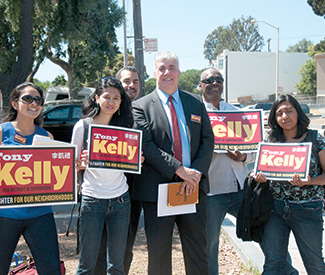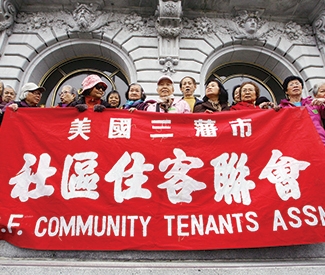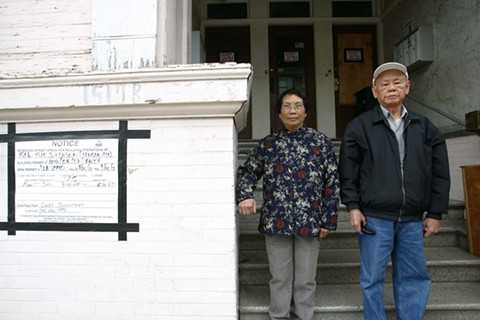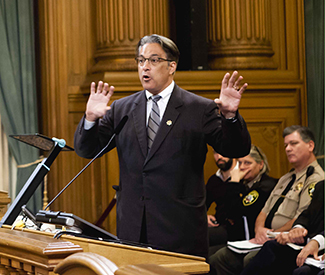FOOD AND DRINK
EDITORS PICKS
Editors picks are chosen by Guardian editors for special recognition for brightening the Bay Area experience.
Juice may be the perky cheerleader in a made-for-tweens drama, but smoothies are the quiet girl that the plot eventually turns on — you know, the one with deeper substance, a touch of shy sweetness, perhaps a few creamy curves. Maybe smoothies aren’t hip to the cleansing trend, and maybe they don’t come packaged in a collectible glass bottle, but nobody puts them in the corner. The ingredient list for Morning Brew Cafe’s Happiness smoothie is deliciously minimal — avocado and whole milk — but your satisfaction will reach maximal heights. The silky combination of rich, ripe avo and thick dairy makes for a delicious sip and a full belly of healthy fat and vitamins. It’s a real meal, great as breakfast or post-workout replenishment. If you’re not a fan of the animal products, request almond milk and reap the additional protein benefits.
401 Sansome, SF. (415) 986-4206, www.morningbrew.com
Yes, you will do it in part for the Instagram. However, the hypebeasts were right on this one: Nombe’s ramenburger is something any self-respecting gourmand in this town has to try. (Curious folks waited over an hour to try one at the SF Street Food Festival, and no one laughed at them.) The burger of Wagyu beef and pork belly tucked between two ramen noodle buns is a culinary voyage, sometimes accompanied by miso, shiitake, and blue cheese if you’re looking for a true umami blast-off. Pro tip: come to Japanese-style izakaya Nombe on half-off wine bottle Wednesday and please, sort out the appropriate photo filter after you eat the thing. This is one burger that is best devoured straight from the kitchen, before the hype (or noodle) has had a chance to cool.
2491 Mission, SF. (415) 681-7150, www.nombesf.com
If San Francisco’s classier pizza joints ever threw down in some kind of mozzarella-fueled turf war, the smart money would be on Capo’s — the year-old North Beach joint that’s just as versed in Prohibition Era gangster culture as it is in tasty pizza. Chef Tony Gemignani clearly knows what he’s doing with his award-winning, Chicago-style pies (four choices of crust, from deep dish to “cracker thin”), but the man also has a flair for décor: hand-painted tin ceiling, a 1930s phone booth that actually functions, a bar that pays homage to the Golden Gate Bridge, and snappy red leather booths themed around gangsters of note — with memorabilia to match. Where else can you enjoy Quattro Forni (a pie specialty made using four ovens!) while admiring poker chips once owned by Al Capone? Nowhere else, wise guy. Capisce?
641 Vallejo, SF. (415) 986-8998, www.sfcapos.com
Even if you don’t much care for piroshkis (although if that’s the case, we feel only sorrow in our hearts for you), the borscht will keep you coming back to Anda Piroshki. Tucked away in the local mini-mall of the Marketplace on Cortland, the counter’s proprietor Anna Tvelova keeps things simple by offering only a handful of menu options. The signature Anda Piroshki borscht is one of the tastiest we’ve ever encountered — no mushy puree, this savory-sweet beet soup is a chunky, earthy stew of slow-cooked veggies and copious dill simmered in a broth and sold in six-dollar pints so flavorful it’s hard to believe that they’re vegan. But they are.
The Marketplace, 331 Cortland, SF. (415) 821-9905, www.andapiroshki.com
One of the most amazing recent dishes to smack the local foodie scene upside the head: Mission Chinese Food’s Chongqing chicken wings, the little crispy limbs buried in so many “explosive” chili peppers that one bite actually numbs your entire mouth. It’s the weirdest, most viscerally addictive experience on our menus. But what if we told you it was also available in cocktail form? Wow and ouch! The Alembic’s Nine Volt leapt onto the ever-innovative Haight Street bar’s summer cocktail menu this year (crafted by bar manager Danny Louie) and zapped us to attention. Served with white Szechuan peppers — yep, sourced from Mission Chinese — but gorgeously balanced with Aviation gin, green tea, and grape juice, this baby gives out a recharging tongue-in-the-socket thrill without any battery-acid stomach repercussions. Here’s hoping the Nine Volt sticks around through winter: we could use the heat.
1725 Haight, SF. (415) 666-0822, www.alembicbar.com
Although it’s been absorbed to an extent by SF Beer Week, Toronado’s annual Barleywine Festival has been around much longer (20 years as of last February), and it eschews the exuberant trappings of most of its festival kin to focus strictly on what’s most essential — the booze. As strong as wine but brewed as a beer, barleywines fall beyond stouts, doppelbocks, and tripels on the strong beer spectrum, and are best savored slowly and with a degree of reverence, which Toronado facilitates with generous, inexpensive sample pours of over 50 varieties from around the world. And, dear hearts, the festival always falls on the weekend closest to Valentine’s Day, making it the perfect destination (or distraction) for the lovers and loners alike.
547 Haight, SF, (415) 863-2276, www.toronado.com
The wait line to get into excellent Inner Richmond Burmese restaurant Burma Superstar is legendary — so legendary that most of us stopped considering it as a dinner option. So when, a few years ago, the owners announced they would be opening a “little sister” down the block named B Star Bar, we rejoiced. B Star Bar kept some of Burma Superstar’s favorites, like the lauded tea leaf salad, but it specialized in innovative Asian comfort food twists. Among the surprises: one of the best brunch menus in the city, including a delectable duck hash quesadilla, succulent tocino (bacon-like Asian jerk pork) with garlic rice, and a full selection of jooks (rice porridge) with all the fixings. But the real brunch superstar here is B Star Bar’s brunch “B Sprouts” — perfectly roasted Brussels sprouts tossed with furikake (rice seasoning), fish sauce, Parmesan, and popped rice that adds a cheery wake-up crunch. The diverse flavors combine so well, we could brunch on these little green gems forever (with mimosas, of course).
127 Clement, SF. (415) 933-9900, www.bstarbar.com
“Pastries for lunch?” Your friends might scoff, but oh, what a surprise they’re in for upon entering this hidden gem tucked between office buildings and business folks. “Banh mi!,” they will exclaim, and although there will not be streamers or confetti to complement their shocked expressions, these little sandwiches will do the delighting in both taste and value. Muffins Muffins, tucked innocuously off Second Street, serves up delicious, made-to-order banh mi for as little as five bucks. The vegetarian option features some tasty faux meat with a tangy finish, topped with jalapeños and hugged by a soft bun. Carry your lunch to nearby Yerba Buena Gardens for a Financial District adventure that doesn’t require a suit or a fatty wallet.
123 Second St, SF. (415) 342-7588
There aren’t many in the craft-spirit making movement who can boast of having a US Navy nuclear engineer as a master distiller. The story goes: Lance Winters came to St. George Spirits and presented founder Jörg Rupf with a homemade batch of whiskey in lieu of resume. He got the job, and under his watch, St. George churned out its single malt whiskey and a line of gins. In 2007, it became the first in the nation to legally release a wormwood liqueur, and continues to be well known for its excellent Absinthe Verte. In a retrofitted Alameda naval hanger turned HQ, test stills are charmed into producing oddball booze flavors including oysters, Dungeness crab, or even the company Christmas tree. “If we’re not pushing the limits of our creativity,” they explain, “our spirits aren’t going to be any different or better than stuff that’s already out there.”
2601 Monarch, Ala. (510) 769-1601, www.stgeorgespirits.com
Oh, you thought Food Network personality Tyler Florence was the celebrity most likely to appear at the elegant American bistro he owns in the Financial District? Nope. Before you even order off the classy-comfort-food menu, you’ll have your brush with fame. Instead of a bread basket (boring!), at your table will appear Wayfare Tavern’s popovers — crisp, golden brown, egg-battered treats so delicious you’ll be tempted to spoil your meal with multiple servings. (And so legendary that several staff members sport popover tattoos.) In August, Florence tapped a new executive chef in Joey Elenterio and word on the street is new menu items will follow, so this might be a grand time to make a reservation. Just keep those popovers coming, please!
558 Sacramento, SF. (415) 772-9060, www.wayfaretavern.com
You know what this place could use? Some no-frills, open-to-all wine tasting. Enter Mugsy Wine Bar, a pop-up most often spotted at El Rio that knows how to class up a place without bringing down the mood, aided by sips from local vintners. The Mugsy tasting notes: “a wine bar with an emphasis on women, urban, and people of color winemakers” with a mouth-feel of “all-around enjoyment.” And this pop-up is pop-cultured. Witness, theme nights: “Mugsy is the New Black” (a play on Netflix smash-hit prison drama series, “Orange is the New Black”) for which the team brought out lesbian-owned Oakland winery Fraina Blanco. Then there was “Popping up for Pride” night, when bottles were uncorked from Alameda’s Rock Wall Wines and Urban Legend Cellars of Oakland. Hooray for local vino pride.
mugsywinebar.tumblr.com
So you’ve just gobbled down an incredible meal at Nopalito that began with a heaping bowl of melted-cheese-covered tortilla chips, followed by carnitas and several bites of your tablemate’s chicken mole. You sipped multiple mezcal-laced cocktails (try the Killer Bee). You are officially stuffed. But when the server comes around asking if you want dessert, there’s only one answer: yes, yes you want in on Nopalito’s housemade popsicles. These paletas hechas en casa may be the only dessert option at either of the restaurant’s two locations, but they’re a thick, rich cut above anything you’ll find in the corner store freezer. There’s a choice of flavors: seasonal fruit or chocolate-cinnamon — the latter like eating a big, ice-cold hunk of Mexican chocolate.
306 Broderick, SF. (415) 437-0303; 1224 Ninth Ave., SF. (415) 233-9966, www.nopalitosf.com
Perish all lunchtime thoughts of those tea-sipping, watercress sandwich-prone Windsors across the pond — in America, our royalty slurps down such delights as fried peanut butter and banana sandos. But, if you’re the worldly sort and prefer a slightly more elegant take on Elvis-inspired cuisine, point your pink Cadillac toward the Lunchpad. At this daytime sandwich pop-up inside new Hayes Valley wine bar Noir Lounge, one can king oneself with an “Almost Elvis,” Nutella and banana on pain de mie (with an add-bacon option, natch). Savory Lunchpad hits include twists on the classics (roast turkey with habañero candied bacon!) and specials (fried chicken sandwich). Oh, and fans of Hollywood royalty take note: A recent lox-and-eggs concoction paid tribute to Leonardo DiCaprio.
581 Hayes, SF. (415) 552-6647, www.thelunchpadsf.com
Born of owner Arcelia Gallardo and co-owner Amelia Gonzalez’ passion for Latin America’s rich pre-Colombian heritage, Casa de Chocolates offers spicy, artisanal iterations of the divine sweet, expertly accented by the flavors of Mesoamerica’s traditional food staples. The women’s dual interests in the culinary and cultural make for an exciting, informed menu — one can pick up a box of mole, passionfruit, guayaba, and tamarind-filled handmade bon-bons, or leave the realm of cacao entire for a silky pumpkin flan or a chipotle caramel. There is such a thing as a tequila-filled chocolate butterfly! Though many items, like a foot-wide dark chocolate rendering of the revered Aztec calendar, are available in the shop’s online store, you’ll have to make an in-person appearance for some specialties including a piquant glass of frozen Mexican chocolate, or standout tres leches cupcakes.
2629 Ashby, Berk. (510) 859-7221, www.casadechocolates.com
Did you think egg creams were something you’d only ever experience onscreen in a teens-of-the-1950s movie? Then welcome the sweet, bustling counter here — named for its owner’s great-grandmother — which is doing its part to bring retro sippin’ to the FiDi lunch masses. While you’re there, it’s well worth sampling one of the Jewish-style deli’s delicious, rye-bread sandwiches or bagel concoctions, but Shorty Goldsteins’ egg creams (made with syrup, milk, and seltzer) are a cult classic in the making, with flavors that usually include vanilla, chocolate, strawberry, and salted caramel. And if you’d prefer not to drink your dessert … Shorty’s thick, decadent cheesecake just might put your head on swivel instead.
126 Sutter, SF. (415) 986-2676, www.shortygoldsteins.com
A cozy bar with unbeatable drink deals, a genre-spanning variety of DJ nights (soul! Classic country! Brazilian! 1950s mod!), undiscovered by the mouth-breathing masses, yet conveniently located just a few meatball-lengths away from the Emmy’s Spaghetti Shack? What is this magical establishment? Look no further than the spot so friendly it’s named El Amigo — offering late-night drink specials and stocking 40 kinds of tequila. Hi! The joint is owned by the same team behind the ever-popular Emmy’s, providing a great perch for drinking away your wait for a table. And join us there for a cheap beer and a shot at midnight, you might become our BFF.
3355 Mission, SF. Facebook: El Amigo Bar
Hayes Valley is a neighborhood in constant flux — witness the condo complex that’s rising where the Hayes Valley Farm’s beehives and veggie rows once stood. Just across Fell Street from this construction is year-old specialty market Nosa Ria (speaking of change, the space was previously a hair salon), selling what its sandwich-board sign dubs “quintessential Spanish foods” — and we dub indubitably delicious. Its list of unique, hard-to-find imports includes grocery staples (cured meats, cheese, olive oils, etc.), wines and sherry, and treats (chocolate! Chupa Chups!). Oh yes, there is that ever-elusive jamon serrano in the house, as well as squid in ink, thick and sweety turron, and all the paella fixings you need, including tha pans. That trip to Galicia and/or Andalusia may be still in the planning stages, but you can start refining your palate ahora.
500 Laguna, SF. (415) 529-1506, www.nosaria.com
Certainly, you can visit this Marina bakeshop without ordering Le Marais Bakery’s Volcan, but this is foolhardy. On your last island getaway did you dither about in the airport gift shop, fretting over gaudy short-sleeve button-downs and plastic leis, tempting as they may be? Of course not, you went straight to the top of Kilauea and delighted in its heart-racing flows and crispy geological crusts. And so you will, bold one, at Le Marais. You’ll save that baguette for later and dive straight into a Volcan, one of the shop’s deep dishes of light and flakey crust, molten ricotta, and some kind of something — Llano Seco pork perhaps, or a smattering of sharp Parmesan. But be warned: any tummy rumblings after this first taste of paradise may signal another trip to Chestnut Street for a buttery, savory baked eruption.
2066 Chestnut, SF. (415) 359-9801, www.lemaraisbakery.com
Ramen is a staple of many an SF diet — especially in the chilly summer months laced with our trademark fog. But the dish almost always includes meat, or at the very least those so-called vegetarian noodles and veggies are floating in warm fish broth. It can seem particularly rude to dissect each element of the noodle bowl at a traditional spot, causing headaches for servers and hungry vegans alike. Enter Ken Ken Ramen, a popular Mission brick-and-mortar location that started as a pop-up. It proudly serves both the traditional stuff, unique nightly specials, and the noodle bowl of vegan dreams. No guessing, it’s labeled clearly on the menu: “Miso Vegan Ramen.” Ah, such a relief filling your belly with warm, tender noodles. And that sizzling bowl includes vegan broth, vegan noodles, and “veggies galore.” Vegans rejoice!
3378 18th St., SF. (415) 967-2636, www.eatkenkenramen.com
Perhaps it is, as the official line of the newly renovated Dogpatch Saloon goes, high time for a 100-year-old bar to undergo a facelift. The bar’s new ownership headed by Christopher Barry, the mind behind downtown’s 83 Proof, seemed like it had its heart in the right place, but the neighborhood bar’s clientele had a right to be worried about the integrity of its comfy watering hole in a rapidly evolving area. Lo and behold: the change was good. Fresh new cocktails lubricate a complete (but not drastic) rehash of the age-old interior, and the characters assembled around the bar continue to convey the scruffy ragtagliness of the dockside ‘hood. We like it when well-loved institutions move smoothly with the times, especially when that motion involves a cocktail shaker.
2496 Third St., SF. (415) 643-8592, www.dogpatchsaloon.com
Houses in the Sunset may be built on dunes, but make no mistake, the neighborhood is no food desert. The flagship of the snacktastic stretch of outer Judah Street (see also: locavore haven Outerlands, beloved Mexican resto Celia’s by the Beach) is without a doubt grocery co-op Other Avenues, about to round the bend on year 40 in the western neighborhood. This is world-class healthy food: happy-making bulk bins, raw milk, vivacious produce, with a thoughtful wine selection and holistic med shelves so complete you’ll never have to trek into neighborhoods that look down on wearing sandals to re-up on herbs and tonics. Plus it’s cute, friendly, and neatly crammed into a smallish storefront, you’ll never lose the gist of your shopping list after giving your neighborhood a hearty “howdy.”
3930 Judah, SF. (415) 661-7475, www.otheravenues.coop
The Mexican-Italian house of Juan Gutierrez opened The Sandwich Place in 1979 when Gutierrez was only 14 years old. A tiny shop that just fits its refrigerator cases full of bevs and counter, the shop sits a stone’s throw from the 16th Street BART station in a bustling milieu of commuters, street preachers, and the occasional demonstration or spoken word open mic. In such a space, one would expect strict utilitarianism. But Gutierrez would scoff at such assumptions — quickly, in his exuberantly bilingual manner. One look at the Place’s vast menu reveals everything from chicken milanesas and bacon-wrapped hot dogs to a superb Portobello-and-balsamic sando from an impressive veggie section, all served on his fresh homemade breads in standard and gluten-free varieties. Better than the chain stores? By a million miles. And chances are, you won’t have to travel even one to find out.
2029 Mission, SF. (415) 431-3811
Back in 1992, inmate counselor Catherine Sneed started pioneering programs for former offenders that eventually led to the implementation of the San Francisco Jail’s Garden Project. This in-jail option gives inmates the time and space to plant and tend their own organically grown food gardens at the Jail’s San Bruno complex as a healthy add-in to their rehabilitation. The program has recently been expanded under Sheriff Ross Mirkarimi, who pushed for and won a new food service contract to ensure more of this yummy nutrition ends up on the plates of inmates who have traditionally had to endure less than wholesome fare. Soon, if the program catches on, jails might have more shared garden space than San Francisco itself.
www.gardenproject.org
“Rich and creamy, baked with love, and served chilled for the California heat” — did Schulzies Bread Pudding sound intriguing until that “chilled” part? Open your mind, bread pudding snob: Sarah Schulz’s Venice Beach-born, super-moist dessert sensation, which added a Hayes Valley location last year, is too delicious to deny (and the shop has warm options to balance out the cold, FYI). Who needs a cupcake or a cronut when you can spoon up fresh-made flavors such as Maple Bacon Lovers (tasty with optional add-ins like whiskey sauce and chocolate chips), Blissed Out Blueberry, or Salted Caramel Charisma? Seriously — who needs to eat any other type of food, ever again?
364 Hayes, SF. (415) 565-7336, www.schulziesbreadpudding.com
Oh, the end of a long night in North Beach. There you are, mercifully relieved of your singles after oh-so-lovely times watching the ladies of the Penthouse Club clack their mega-heels all up and down the two-story stripper poles. You’re satiated in the “make it rain” department … but damn, are you hungry. Enter Taqueria Zorro’s Zorro burrito, there to stuff your belly and slash “satisfied” across your chest. What’s in the Zorro, you ask? Well, all the same things you’ve come to expect from a burrito, except instead of using traditional rice and beans they stuff the burrito with French fries. This so-called “California burrito” version, supposedly hailing from San Diego in the ’80s is all the carb-filled rage these days — GQ even claimed last month that it would soon replace the ramenburger (see above) in hip factor. And yeah, you can spot it soaking through menus across the Mission. But Zorro got there first and left its greasy, irresistible mark.
308 Columbus, SF. (415) 392-1299, www.taqueriazorro.com
You’re welcome to play it safe tastewise in Willy Wonka-like soda paradise The Fizzary. Pop a familiar bottle of orange into the joint’s charming quick chill device, crack, and glug. But even amid that flavor’s designated shelf of sodas you’ll find intriguing variations — a bottle flown in from the Phillipines, a blood orange variation innocuously lounging, a five-gallon jug of your childhood favorite fizz to take your sugar highs to new altitudes. Venture out of the known soda universe — that seems to be what local bubble bottlers Taylor’s Tonics wanted when they opened up this quirky shop selling theirs and other carbonated treats — plus retro and hard-to-find candies — in the Mission. A quick listing of the other flavors you may encounter on the shelves and your tastebuds quiver. Chocolate, lavender, clove, bacon, spruce, amaretto, and cucumber from manufacturers the world over.
2949 Mission, SF. (877) 368-4608, www.thefizzary.com
Light fare it is not, but are we ever glad to have come around to the gravy-like consistency and rich, complex flavors of Japanese curry. Nothing seems more homey or satisfying than when the comforting heft of a curry-laden lunch plate — chicken or pork katsu, tender cubed beef, steaming veggie, etc. versions available — is directed toward your waiting mouth, a feat made possible at the Financial District’s Muracci’s (a joint that now has a sister location in Los Altos.) Venture here for some of the best Japanese curry that we’ve found in town, served up in a small, no-frills space with less than a dozen seats. Plus: sides of pickles! Be not afraid of the line, an apt indicator of the number of J-curry fans in this town — thanks to Muracci’s efficient express plates, the queue moves fast enough to satisfy even our most ravenous lunchtime cravings.
307 Kearny, SF. (415) 773-1101, www.muraccis.com
When the sound system at your restaurant outstrips the food when it comes to rave reviews, you might have a problem. But the folks at Berkeleys’s elegant, spare, and forward-thinking Comal are confident enough in their menu to take us to the next level of sensual experience. The haute-Mexican cuisine, emphasizing deep flavors and grilled textures, speaks for itself. But the sound of the place speaks volumes. In order to better control the sonic ambiance of the place — and perhaps to diffuse the persnicketiness of SF’s most prominent food critic, whose aversion to dining room noise is legendary — Comal’s owner John Paluska installed a new, state-of-the-art Libra acoustic image system and complementary Constellation active acoustic system from Meyer Sound. Through a series of unobstrusive iPad-controlled speakers and acoustic absorption tiles, managers can control the “buzz” levels of the place, “washing” and basically “whitening” the noise as needed to quiet things down. The can even turn up the buzz around the bar — although with several flights of tequila on the menu, there’s probably enough buzz already.
2020 Shattuck, SF. (510) 926.6300, www.comalberkeley.com
It is with good reason that Hella Vegan Eats’ doughnut burger was the runaway star of the San Francisco Street Food Festival this year. No false modesty here: the Bay Guardian had already been praising that sticky delicious beet burger for months, even giving it top billing in our “Vegan Junk Food” feature. But no matter who broke the story; the real scoop here is that special dish, lovingly crafted by couple-founders Tiffany and Sylvee Esquivel, and showing up regularly at places like Dear Mom, Timeless Coffee in Oakland, and Dolores Park through La Cocina. Dig its moist-yet-crunchy patty fashioned from freekah (an ancient cereal) and beets and plopped between two (vegan) sugar donuts, piled high with pickled veggies, and laced with a tangy secret sauce. So wrong that it’s right.
www.hellaveganeats.com
Appropriately, the Chapel opened last year with a string of concerts by the Preservation Hall Jazz Band, a group named for its origin point at NOLA’s Preservation Hall jazz venue. That’s the spot Valencia Street’s new place for music worship (officially known as Preservation Hall West at the Chapel) is modeled after, and endlessly inspired by, be it in in the form of design, live music, or eats. This year, the well-crafted, multilevel, many-roomed Chapel has expanded its musical offerings, dabbling in folk, rock’n’roll, and indie bands like La Sera, Magic Trick, and Weekend, along with more traditional jazz acts, and what-the-hell randomly awesome offerings like Sparks or actor-musician John C. Reilly with Lavender Diamond. It also opened the attached Vestry Restaurant, which offers a full menu leaning more on the SF gourmet side, with items like the duck confit flatbread or seared scallops with beet risotto. During shows, patrons can peep live acts from the open upstairs balcony, from the dramatic main room down below, or perched on a bar stool in the shiny wooded lounge with closed-circuit flat screens, high-end cocktails like the Old Overholt rye-based Ward Eight, and yummy bar bites like shrimp po’ boys that subtly wink at NOLA pride.
777 Valencia, SF. (415) 551-5157, www.thechapelsf.com
You may see Rocky Yazzie at the best live venues around town doing one of two things. Either he’s rocking coveralls and slinging authentic Native American fry bread, or banging it out with his self-described “pow wow punk” band, Sweat Lodge. Either way, you’ll be glad to have stumbled into his special Rocky bubble. A few words on his Rocky’s Fry Bread snacks, perhaps the better known of the two projects. The New Mexico native and member of the Diné tribe makes deliciously deep-fried taco-like handheld meals, stuffed with beans and fresh veggies (there are non-veg versions as well), behind his own pop-up stand. There’s something about that fry bread that just perfectly soaks up all the boozing without landing like a log in your tummy. As the friendly slinger once explained it to Scoutmob, “I love life and it shows in the food.”
www.twitter.com/RockysFrybread
An invention that seems perfect for the busy-yet-locavore-obsessed Bay Area (though test markets are popping up in Brooklyn, New Orleans, and LA) sustainable ready-to-eat delivery service Good Eggs seems to have it all. But for our money — and yes, it’s not exactly cheap — there is one among Eggs’ many intriguing, locally produced offerings that intrigues the most: caterer Max Pouvreau’s Petit Pot. Did you know that everything tastes better in a Weck jar? This is the height of Bay food trendiness on the go: Try jarred lamb shoulder and spring onion tagine with prunes and roasted almonds, followed by a jarred dark chocolate buttermilk cake with coffee whipped cream and cocoa nibs. All delivered to your door! Bonus: $3 deposits on your round glass meal carriers means return customers get a sweet (savory?) discount.
www.goodeggs.com/petitpot
Spurn the crowds across the street at ever-popular Taqueria Cancun’s Bernal-side outpost. You, a seasoned Missionite, have had your fill of what one of our dear ones likes to call “the Mexican death log.” Burrito fiend you are not — which is why in your wisdom your tummy’s late night call has led you to a late-night Salvadorean restaurant, sounding thusly: “pupusa…” They’re no baby-sized gut bomb, the pupusas at El Zocalo. These traditional steaming pocket-like snacks come stuffed with cheese (of course), but also zucchini, loroco, feta even for those sick of stringy quesos. And lucky you, the family joint stays open until three in the morning, so it’s ready for whenever you graduate to the next level with San Francisco snacking.
3230 Mission, SF. (415) 282-2572
Watch live flamenco and Arabian fusion music while you dance with a side of papas bravas and plantains. Take in the All-Star Latin Band on weekly Cuban and world music nights while munching Andean fresh corn tamales and yuca frita with cashew cream. Yes, North Beach’s intimate cultural center and restaurant Peña Pachamama (“on a little side street in San Francisco’s old Latin Quarter somewhere between Chinatown, Fisherman’s Wharf, and endless Italian late-night cafes”) offers up such startlingly refreshing culinary-auditory pairings, nearly every night of the week. The friendly South American restaurant and performance venue offers an exceptional range of cultural treats for your tummy and mind, and begs this simple question: why is it so damn hard to find vegan, gluten free, and/or deliciously organic cuisine at other music venues in veg-friendly San Francisco? No matter — Peña Pachamama has already delivered the goods, and they are spicy.
1630 Powell, SF. (415) 646-0018, pachamamacenter.org
Friends, we have eaten gold leaf. That’s what they’re serving these days at the new digs of the most lauded restaurant in SF, Saison: a voluptuous dish of sea urchin over grilled root custard in a handmade Japanese ceramic bowl, topped with a generous skin of melted gold. (Let’s settle one question right away: no, our toilet wasn’t gilded the next morning. Nor did we use the leaf to fake a grill.) It’s part of the $248 tasting menu, $396 with insane wine pairing, at this two-star Michelin hotspot. Don’t worry, there’s a bar menu featuring reserve caviar dolloped over corn pudding and grilled Australian black truffle stew, both at $88, cough. Look, we have to hand it to renegade chef Joshua Skenes and sommelier and co-owner Mark Bright — if you ever can/want to shell out $400 for a meal (ours was a press comp), this is the absolutely perfect one. Fourteen courses of the best the world has to offer, served in jaw-dropping ways. Yet it was the metaphorical combination of the dish mentioned above — gold smothering an urchin — that rang particularly true of this moment in San Francisco history. The delicious, flashy rush. And then what lies beneath it, left behind.
178 Townsend, SF. (415) 828-7990, www.saisonsf.com









